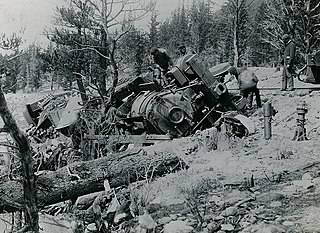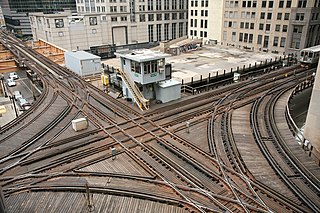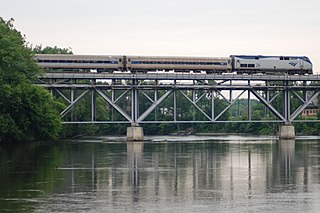
The Acela is Amtrak's flagship passenger train service along the Northeast Corridor (NEC) in the Northeastern United States between Washington, D.C., and Boston via 13 intermediate stops, including Baltimore, New York City and Philadelphia. Acela trains are the fastest in the Americas, reaching 150 miles per hour (240 km/h), but only over 49.9 miles (80.3 km) of the 457-mile (735 km) route.

The Northeast Corridor (NEC) is an electrified railroad line in the Northeast megalopolis of the United States. Owned primarily by Amtrak, it runs from Boston in the north to Washington, D.C. in the south, with major stops in Providence, New Haven, Stamford, New York City, Newark, Trenton, Philadelphia, Wilmington, and Baltimore. The NEC closely parallels Interstate 95 for most of its length. Carrying more than 2,200 trains a day, it is the busiest passenger rail line in the United States by ridership and by service frequency.

In rail transport, a derailment is a type of train wreck that occurs when a rail vehicle such as a train comes off its rails. Although many derailments are minor, all result in temporary disruption of the proper operation of the railway system and they are a potentially serious hazard.

The Southeast Corridor (SEC) is a proposed passenger rail transportation project in the Mid-Atlantic and Southeastern United States to extend high-speed passenger rail services from the current southern terminus of the Northeast Corridor in Washington, D.C.. Routes would extend south via Richmond and Petersburg, Virginia, with a spur to Norfolk in Virginia's Hampton Roads region; the mainline would continue south to Raleigh, Durham, Greensboro, and Charlotte, North Carolina. Since the corridor was first established in 1992, the U.S. Department of Transportation (USDOT) has extended it further to Atlanta, Georgia and Macon, Georgia; Greenville, South Carolina; Columbia, South Carolina; Jacksonville, Florida; and Birmingham, Alabama.

The Keystone Corridor is a 349-mile (562 km) railroad corridor between Philadelphia and Pittsburgh, Pennsylvania, that consists of two rail lines: Amtrak and SEPTA's Philadelphia-to-Harrisburg main line, which hosts SEPTA's Paoli/Thorndale Line commuter rail service, and Amtrak's Keystone Service and Pennsylvanian inter-city trains; and the Norfolk Southern Pittsburgh Line. The corridor was originally the Main Line of the Pennsylvania Railroad.

On January 4, 1987, two trains collided on Amtrak's Northeast Corridor main line near Chase, Maryland, United States, at Gunpow Interlocking. Amtrak train 94, the Colonial, traveling north from Washington, D.C., to Boston, crashed at over 100 miles per hour (160 km/h) into a set of Conrail locomotives running light which had fouled the mainline. Fourteen passengers on the Amtrak train died, as well as the Amtrak engineer and lounge car attendant.

Plans for high-speed rail in the United States date back to the High-Speed Ground Transportation Act of 1965. Various state and federal proposals have followed. Despite being one of the world's first countries to get high-speed trains, it failed to spread. Definitions of what constitutes high-speed rail vary, including a range of speeds over 110 mph (180 km/h) and dedicated rail lines. Inter-city rail with top speeds between 90 and 125 mph is sometimes referred to in the United States as higher-speed rail.

The Wolverine is a higher-speed passenger train service operated by Amtrak as part of its Michigan Services. The 304-mile (489 km) line provides three daily round-trips between Chicago and Pontiac, Michigan, via Ann Arbor and Detroit. It carries a heritage train name descended from the New York Central.

In railway engineering, cant deficiency is defined in the context of travel of a rail vehicle at constant speed on a constant-radius curve. Cant itself refers to the superelevation of the curve, that is, the difference between the elevations of the outside and inside rails. Cant deficiency is present when a rail vehicle's speed on the curve is greater than the speed at which the components of wheel to rail force are normal to the plane of the track. In that case, the resultant force exerts on the outside rail more than the inside rail, in which it creates lateral acceleration toward the outside of the curve. In order to reduce cant deficiency, the speed can be reduced or the superelevation can be increased. The amount of cant deficiency is expressed in terms of required superelevation to be added in order to bring the resultant force into balance between the two rails.

Positive train control (PTC) is a family of automatic train protection systems deployed in the United States. Most of the United States' national rail network mileage has a form of PTC. These systems are generally designed to check that trains are moving safely and to stop them when they are not.

In railway engineering, curve resistance is a part of train resistance, namely the additional rolling resistance a train must overcome when travelling on a curved section of track. Curve resistance is typically measured in per mille, with the correct physical unit being Newton per kilo-Newton (N/kN). Older texts still use the wrong unit of kilogram-force per tonne (kgf/t).
The Northern Lights Express (NLX) is a planned higher-speed rail service that would run 155 miles (249 km) between Minneapolis and Duluth primarily in the U.S. state of Minnesota. A portion of the proposed line would run through neighboring Wisconsin to serve Duluth's "Twin Port" of Superior. Plans are to upgrade an existing BNSF Railway freight line to allow trains to travel at up to 90 miles per hour (145 km/h). The train service is said to provide an alternative to traveling Interstate 35 between Duluth and the Twin Cities or to other destinations along the line such as the casino in Hinckley.

The minimum railway curve radius is the shortest allowable design radius for the centerline of railway tracks under a particular set of conditions. It has an important bearing on construction costs and operating costs and, in combination with superelevation in the case of train tracks, determines the maximum safe speed of a curve. The minimum radius of a curve is one parameter in the design of railway vehicles as well as trams; monorails and automated guideways are also subject to a minimum radius.

The Michigan Line, sometimes known as the Chicago–Detroit Line, is a higher-speed rail corridor that runs between Porter, Indiana and Dearborn, Michigan. It carries Amtrak's Blue Water and Wolverine services, as well as the occasional freight train operated by Norfolk Southern.

Higher-speed rail (HrSR), also known as high-performance rail, higher-performance rail, semi-high-speed rail or almost-high-speed rail, is the jargon used to describe inter-city passenger rail services that have top speeds of more than conventional rail but are not high enough to be called high-speed rail services. The term is also used by planners to identify the incremental rail improvements to increase train speeds and reduce travel time as alternatives to larger efforts to create or expand the high-speed rail networks.

Track geometry is concerned with the properties and relations of points, lines, curves, and surfaces in the three-dimensional positioning of railroad track. The term is also applied to measurements used in design, construction and maintenance of track. Track geometry involves standards, speed limits and other regulations in the areas of track gauge, alignment, elevation, curvature and track surface. Standards are usually separately expressed for horizontal and vertical layouts although track geometry is three-dimensional.

On the morning of December 1, 2013, a Metro-North Railroad Hudson Line passenger train derailed near the Spuyten Duyvil station in the New York City borough of the Bronx. Four of the 115 passengers were killed and another 61 injured; the accident caused $9 million worth of damage. It was the deadliest train accident within New York City since a 1991 subway derailment in Manhattan, and the first accident in Metro-North's history to result in passenger fatalities. The additional $60 million in legal claims paid out as of 2020 have also made it the costliest accident in Metro-North's history.

The cant of a railway track or camber of a road is the rate of change in elevation (height) between the two rails or edges of the road. This is normally greater where the railway or road is curved; raising the outer rail or the outer edge of the road creates a banked turn, thus allowing vehicles to travel round the curve at greater speeds than would be possible if the surface were level.

The 2015 Philadelphia train derailment of a New York City-bound Amtrak train in Kensington, Philadelphia, Pennsylvania in the United States resulted in multiple passenger injuries and deaths and disrupted Amtrak service for several days afterward due to the resulting investigation and removal of the wrecked train cars.

The first-generation Acela Express trainset is a unique set of vehicles used on the Acela, Amtrak's flagship high-speed service along the Northeast Corridor (NEC) in the Northeastern United States. When they debuted in 2000, the sets were the fastest in the Americas, reaching 150 mph (240 km/h) on 33.9 mi (54.6 km) of the route. They were built between 1998 and 2001 by a consortium of Alstom and Bombardier. Each set has two power cars derived from units that Alstom built for the TGV, and six passenger cars derived from the LRC that Bombardier built for Via Rail.
























